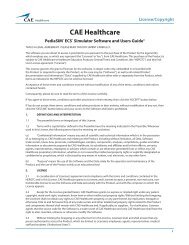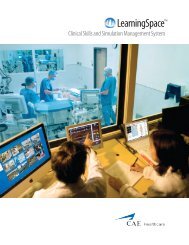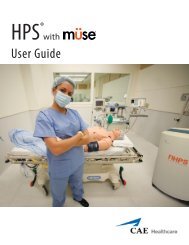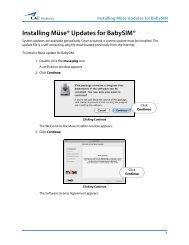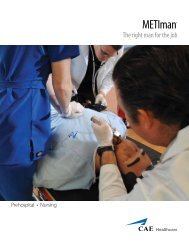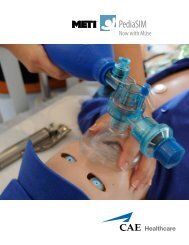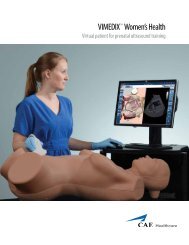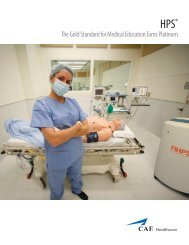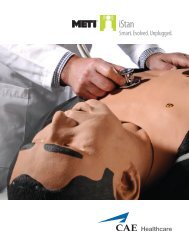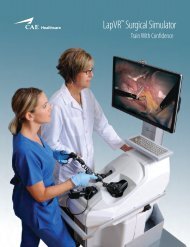Brochure - CAE Healthcare
Brochure - CAE Healthcare
Brochure - CAE Healthcare
You also want an ePaper? Increase the reach of your titles
YUMPU automatically turns print PDFs into web optimized ePapers that Google loves.
BabySIM<br />
Babies Need Special Care
Caring for our most<br />
precious patients.<br />
Bulging<br />
fontanel<br />
capability<br />
Blinking eyes<br />
Variable pupil<br />
size<br />
Tearing and<br />
secretions<br />
of fluids<br />
from ears,<br />
eyes and<br />
mouth<br />
Realistic<br />
airway<br />
Crying,<br />
cooing,<br />
giggling<br />
Trachea<br />
with realistic<br />
anatomical<br />
landmarks<br />
Chest excursion<br />
Seesaw breathing<br />
Heart sounds<br />
Breath sounds<br />
Unilateral needle<br />
decompression and<br />
chest tube insertion<br />
Bilateral brachial<br />
and femoral<br />
pulses<br />
Bowel<br />
sounds<br />
Interchangeable<br />
genitalia<br />
Urine output
Intraosseous<br />
insertion<br />
Babies Need Special Care<br />
Treating a critically-ill infant requires a unique skill set that<br />
can only come from hands-on, real time experience. Knowing<br />
what to look for and how to find answers — quickly<br />
and with no mistakes — is essential. But this kind of experience<br />
can’t come from exposure to critical care situations in<br />
practice. The stakes are simply too high and the patients<br />
too precious. When a parent hands over their sick baby to a<br />
medical professional, they are counting on a miracle.<br />
BabySIM incorporates highly developed infant physiological<br />
models that generate realistic and automatic responses<br />
to clinical interventions and drug administration. Unlike a<br />
task-trainer, BabySIM automatically responds to learner interventions<br />
and represents a true-to-life response to these<br />
interventions. By providing a realistic means to bridge<br />
the gap from didactic learning to clinical application, the<br />
BabySIM provides the best transition for learners to apply<br />
their knowledge of infant patient care in a safe, no-risk environment.
Patient Status Display<br />
provides a fully<br />
customizable,<br />
manageable view of<br />
patient data. Colors<br />
and alarms can be<br />
modified directly from<br />
the Run Screen as well.<br />
Recent Event Logs on<br />
the Run Screen keep<br />
you updated, while<br />
complete event and<br />
physiological data<br />
is logged in the SCE<br />
history.<br />
Scenarios automatically<br />
load as part of the SCE.<br />
Scenario states and<br />
progression can<br />
be controlled directly<br />
from the Run Screen.<br />
BabySIM comes standard with <strong>CAE</strong> <strong>Healthcare</strong>’s extraordinary user interface, Müse. From<br />
running your simulator to accessing and managing patients and scenarios, Müse offers<br />
drag-and-drop simplicity and touch-screen capability making control as simple as a<br />
tap of the finger. Müse runs on web-based technology so it connects wirelessly to your<br />
network and comes with TouchPro Patient Monitor software including capnography.<br />
Simulated Clinical Experiences (SCEs)<br />
bundle ready-to-go patients, scenarios,<br />
educational content and setup<br />
preferences to automatically load<br />
together when you run a SCE.<br />
Parameter controls allow<br />
you to affect the physiological<br />
modeling with<br />
the click of a button.<br />
SCE timeline provides the ability to<br />
place bookmarks throughout a SCE<br />
and to return to the patient’s bookmarked<br />
physiology at any point.<br />
Patient reset button allows<br />
you to quickly save and<br />
return to the patient’s original<br />
baseline physiology without<br />
having to restart the SCE.
The fully customizable<br />
Quick Links lists help<br />
you easily and accurately<br />
apply complex<br />
medical conditions,<br />
medications and<br />
interventions directly<br />
from the Run Screen.<br />
Fluid loss and<br />
administration<br />
controls support<br />
varying rates.<br />
Multi-user, unique<br />
password system<br />
allows institutions to<br />
predefine privileges of<br />
users and operators.<br />
Medication Monitor shows current concentration of any administered<br />
medication in the patient. Administered drugs can be “reset,”<br />
immediately removing all effects of the medication from the<br />
patient for training purposes.<br />
TouchPro Simulated Patient Monitoring<br />
Software<br />
Müse comes with the TouchPro Patient Monitoring<br />
software that looks and acts just like a real-world patient<br />
monitor including touch-screen capability and capnography.<br />
• Operates wirelessly or via wired Ethernet<br />
• Can be run on a touch-screen computer or tablet<br />
• Waveforms and numeric vitals can be changed with<br />
drag-and-drop simplicity<br />
• Can display up to six waveform traces and four<br />
numeric vitals<br />
• Web-based for PC or Mac<br />
SCE Development Software<br />
Create and edit Müse patient scenarios on any Mac or PC<br />
when away from the instructor’s workstation. Four standalone<br />
licenses included with the purchase of each simulator.<br />
Waveform Selection<br />
• ECG Lead I<br />
• ECG Lead II<br />
• ECG Lead III<br />
• ECG Lead V<br />
• Arterial Blood Pressure<br />
Numeric Selection<br />
• Heart Rate<br />
• Pulse<br />
• Arterial Blood Pressure<br />
• MAP<br />
• NIBP<br />
• Pulmonary Artery Pressure<br />
• PCWP<br />
• Central Venous Pressure<br />
• Continuous Cardiac<br />
Output<br />
• Thermodilution Cardiac<br />
Output<br />
• Respiratory Rate<br />
• Central Venous Pressure<br />
• Optoplethysmograph<br />
• Capnogram<br />
• Pulmonary Blood<br />
Pressure<br />
• SpO2<br />
• PAO2<br />
• PaO2<br />
• PACO2<br />
• PaCO2<br />
• EtCO2<br />
• PvO2<br />
• PvCO2<br />
• ICP<br />
• Body Temperature<br />
• Blood Temperature<br />
• Axillary Temperature<br />
• Rectal Temperature
BabySIM Clinical Features<br />
INFANT MANNEQUIN<br />
A complete reproduction of an actual six<br />
to nine month infant patient measuring<br />
25.75 inches (65.4 cm) tall, weighing 16.25<br />
pounds (7.37 kg) and fully operational in<br />
the supine, lateral and sitting positions.<br />
HEAD ANATOMICAL FEATURES<br />
The infant mannequin head offers tremendous<br />
realism with features such as:<br />
• Articulating mandible that supports<br />
mask ventilation<br />
• Functional eyelids with blink settings<br />
and three manually adjusted pupil<br />
settings (normal, pinpoint and blown)<br />
• Exhalation of air and CO 2<br />
• Preset sounds such as crying,<br />
cooing and giggling<br />
• Secretions from the eyes, ears and mouth<br />
• Palpable anterior fontanel with intra-<br />
cranial pressure of normal to bulging<br />
AIRWAY FEATURES<br />
BabySIM provides an anatomically realistic<br />
upper airway that includes all of the following<br />
features:<br />
• Hard and Soft Palate<br />
• Oropharynx<br />
• Nasopharynx<br />
• Laryngopharynx<br />
• Conical Trachea<br />
• Carina<br />
• Clinical Device use such as a LMA<br />
• Spontaneous and Mechanical<br />
Ventilation<br />
GENITOURINARY<br />
• Male and Female Genitalia<br />
• Urine Output<br />
THORAX AND PERIPHERY<br />
FEATURES<br />
The infant mannequin was designed to<br />
support a wide range of clinical interventions.<br />
Each of the following features helps<br />
to isolate specific learning objectives:<br />
• Bilateral Chest Excursion<br />
• Bilateral Breath Sounds—normal and<br />
abnormal—synchronized with<br />
breathing and independently<br />
synchronized ventilation<br />
• Seesaw breathing<br />
• Synchronized Heart Sounds (normal<br />
and abnormal)<br />
• Chest Compressions – generate<br />
palpable pulses, artificial circulation,<br />
cardiac output, peripheral blood<br />
pressures, and CO 2 return<br />
• 3-Lead ECG Monitoring<br />
• Cardiac Pacing<br />
• Synchronized Cardioversion<br />
• Defibrillation<br />
• Needle Decompression (unilateral)<br />
• Chest Tube Insertion with Drainage<br />
(unilateral)<br />
• Auscultation of Korotkoff Sounds<br />
• Bowel Sounds<br />
• Four Bilateral Pulses (brachial and<br />
femoral)<br />
TRAUMA FEATURES<br />
BabySIM provides airway trauma features<br />
that allow for the use of appropriate clinical<br />
supplies and equipment and include all of<br />
the following:<br />
• Laryngospasm<br />
• Bronchial Occlusion<br />
• Esophageal, Nasal and Oral Intubation<br />
• End Tidal CO2 Detection via Colormetric<br />
Device (ETCO 2 )<br />
Additionally, the mannequin provides<br />
critical airway landmarks, allowing for the<br />
following accurate respiratory therapeutic<br />
interventions:<br />
• Oropharyngeal Intubation<br />
• Nasopharyngeal Intubation<br />
• Bag-Valve-Mask (BVM) Ventilation<br />
• Laryngoscopic Procedures<br />
• Endotracheal Tube Intubation<br />
PHARMACOLOGY FEATURES<br />
The BabySIM mannequin has IV access site<br />
(femoral) and a specific infant drug library<br />
designed to isolate critical pharmacology<br />
learning objectives. Pharmacokinetics and<br />
pharmacodynamics are pre-programmed.
Enhance your learning experience<br />
METI Learning Modules include a collection of<br />
carefully defined Simulated Clinical Experiences<br />
(SCEs) that allow you to easily integrate<br />
specific learning content into your program.<br />
Below are just some of the learning modules<br />
available for BabySIM, for a complete list visit<br />
caehealthcare.com.<br />
Infant nursing Learning Module<br />
Includes eight SCEs developed from the<br />
Program for Nursing Curriculum Integration<br />
(PNCI®) for those specifically interested in<br />
simulations involving the care of an infant<br />
patient.<br />
• Abandoned Healthy Newborn<br />
• Congenital Cardiac Abnormalities<br />
• Myelomeningocele<br />
• Newborn with Respiratory Distress<br />
• Care of a Baby with RSV Bronchiolitis<br />
• Septic Baby Secondary to Prolonged<br />
Rupture of Membranes<br />
• Shaken Baby Syndrome<br />
• Substance Exposed Neonate<br />
Infant emergencies Learning<br />
Module<br />
Includes eight SCEs that are designed to teach<br />
common medical emergencies that are most<br />
often associated with babies and infants.<br />
• Burn Injury<br />
• Submersion Injury<br />
• Electrocution<br />
• Envenomation<br />
• Gunshot Wound<br />
• Meningitis<br />
• Methamphetamine Exposure<br />
• Traumatic Brain Injury<br />
STANDARD EQUIPMENT<br />
• BabySIM Mannequin<br />
• Power and Communications Unit (PCU)<br />
• Instructor’s Laptop Workstation<br />
• Waveform Display Monitor<br />
• Müse® Software<br />
• Two preconfigured patients and<br />
four preconfigured SCEs<br />
• TouchPro Software<br />
• 4 SCE Development Software Licenses<br />
• Mannequin Carrying Case<br />
OPTIONAL EQUIPMENT<br />
• Auxiliary Portable Power Supply<br />
• Air Compressor<br />
• Remote Control Laptop<br />
• Computer Bag<br />
• Gas Accessory Kit<br />
• TouchPro Patient Monitor Computer<br />
• Training<br />
• Installation & Orientation<br />
• Support & Maintenance Upgrade<br />
• Pharmacology Editor
© 2012 <strong>CAE</strong> <strong>Healthcare</strong> 321-0212<br />
<strong>CAE</strong> <strong>Healthcare</strong> offers advanced patient, imaging, surgical and learning simulation-based<br />
solutions to improve patient safety and outcomes. Our leading-edge products and learning applications<br />
provide risk-free practice and professional development to physicians, nurses, EMS<br />
responders, military medics, students and allied health professionals around the world.<br />
caehealthcare.com<br />
For more information about <strong>CAE</strong> <strong>Healthcare</strong><br />
products, contact your regional sales manager,<br />
the <strong>CAE</strong> <strong>Healthcare</strong> distributor in your country,<br />
or visit caehealthcare.com.<br />
Tel +1 941-377-5562<br />
Toll-free in North America 866-233-6384



